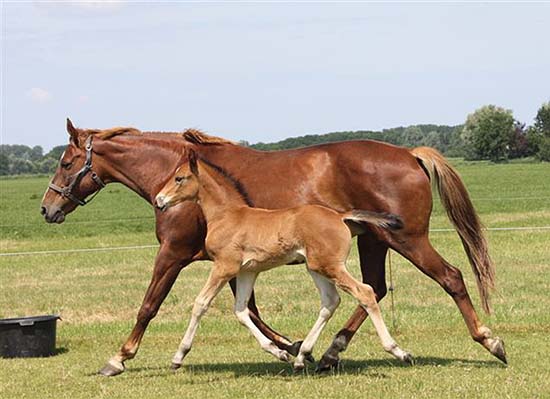By Dr. Mariette van den Berg – BAppSc (Hons), PhD (Equine Nutrition) Illustrations: Dr. Mariette van den Berg
‘The importance of monitoring body condition and weight management in broodmares’ is part one of a four-part series that will address a number of related topics, in the coming months, including the nutritional requirements of broodmares and growing horses (Part 2); Balancing pasture intake and supplementary feeding for breeding and growing horses (Part 3); and An introduction to managing soil and pastures for horses (Part 4).
The feeding management of broodmares (and growing foals) is one of the most important and challenging areas for mare owners and health professionals. Mares have the important task to grow a healthy foal inside them for 11 months and produce enough milk for that foal to last for at least six months or longer. In addition, many owners have the intention to have their mares raising healthy foals for multiple years, requiring successful rebreeding while the previous year's foal is still by her side. It is well known and demonstrated by research that the diet of the broodmare can influence conception, early embryonic loss and abortion, the skeletal development and growth of the foal, and the ability to recover from foaling and milk production. Therefore, understanding the nutritional needs of the maiden/barren (for conception), pregnant (early, mid, and late gestation) and lactating mare is essential for the development of a proper feeding and grazing program for all stages to ensure overall reproductive success.
Overfeeding and underfeeding, especially related to energy intake, are common issues in the management of mares and can lead to various (long term) health implications for the mare and can affect the mare’s conception rate and growth of the foal. In addition, low levels of minerals and trace minerals in pregnant mare diets have been shown to increase the risk of skeletal disease in foals. Balancing the dietary requirements is therefore paramount in any management program, and this starts with monitoring feed intake and the weight/condition of your mares.
Body condition scoring
Body condition scoring serves as an effective means to evaluate the horse’s weight and overall health and its nutritional status. Various countries may use different scoring systems to determine the body condition of your horse. They often go from a score of 1 to 5 or 1 to 9. The scores are related to the different body fat deposits on the horses’ body. For the purpose of this series we will describe the ‘Henneke’s scoring system’ that is inter-nationally used by veterinarians and equine nutritionists.
To evaluate your horse’s body condition, equine nutritionist and veterinarians use a standard system of checks, developed by Don Henneke, PhD, whose illustration and chart originally appeared in the Equine Veterinary Journal in 1983. The system involves massaging and scoring six main parts of the horse’s body – neck, withers, shoulder, ribs, loin, and tailhead (see figure 1) – on a scale of 1 to 9 for their fat/muscle content (see table 1). A score of 1 is considered to be a poor or emaciated horse with no body fat, while a 9 is extremely fat or obese.
To get your horse’s body condition score you record the scores of each of these areas separate using table 1 as your reference. The first place to look when assessing the different regions is the ribs. These are easily seen when horses are below a score of 5. Over a score of 5 the ribs are no longer visible but can be easily felt. The ribs become more difficult to feel when horses have a body condition score above 7. During winter and spring, it might be difficult to see ribs because of the horse’s coat, so it is always important to run your fingers across the ribcage to assign the correct score. Following the ribs you can work your way along the other regions, behind shoulder, withers, neck, loins, and tail head. Evaluating the body condition of pregnant mares may become more difficult during late gestation, as the combined weight of the foetus and amniotic fluid may pull the skin tightly over the vertebral column and ribcage. Therefore, it’s best to place emphasis on other key areas: along the withers, behind the shoulder, and around the tailhead.
Note that not all horses get the same score at each location. Once you’ve recorded all the scores you calculate the average to get your final body condition score. For research purposes, the overall score can have decimal numbers, but for practical purposes, most people would record a value of 6+ or 7-. For example, a horse might score 6 on some areas and 7 on others, resulting in an average score of 6+... To read the complete article you need to be a subscriber
CLICK HERE TO SUBSCRIBE TO BREEDING NEWS
SUBSCRIBERS CAN READ THE COMPLETE ARTICLE BY LOGGING IN AND RETURNING TO THIS PAGE




